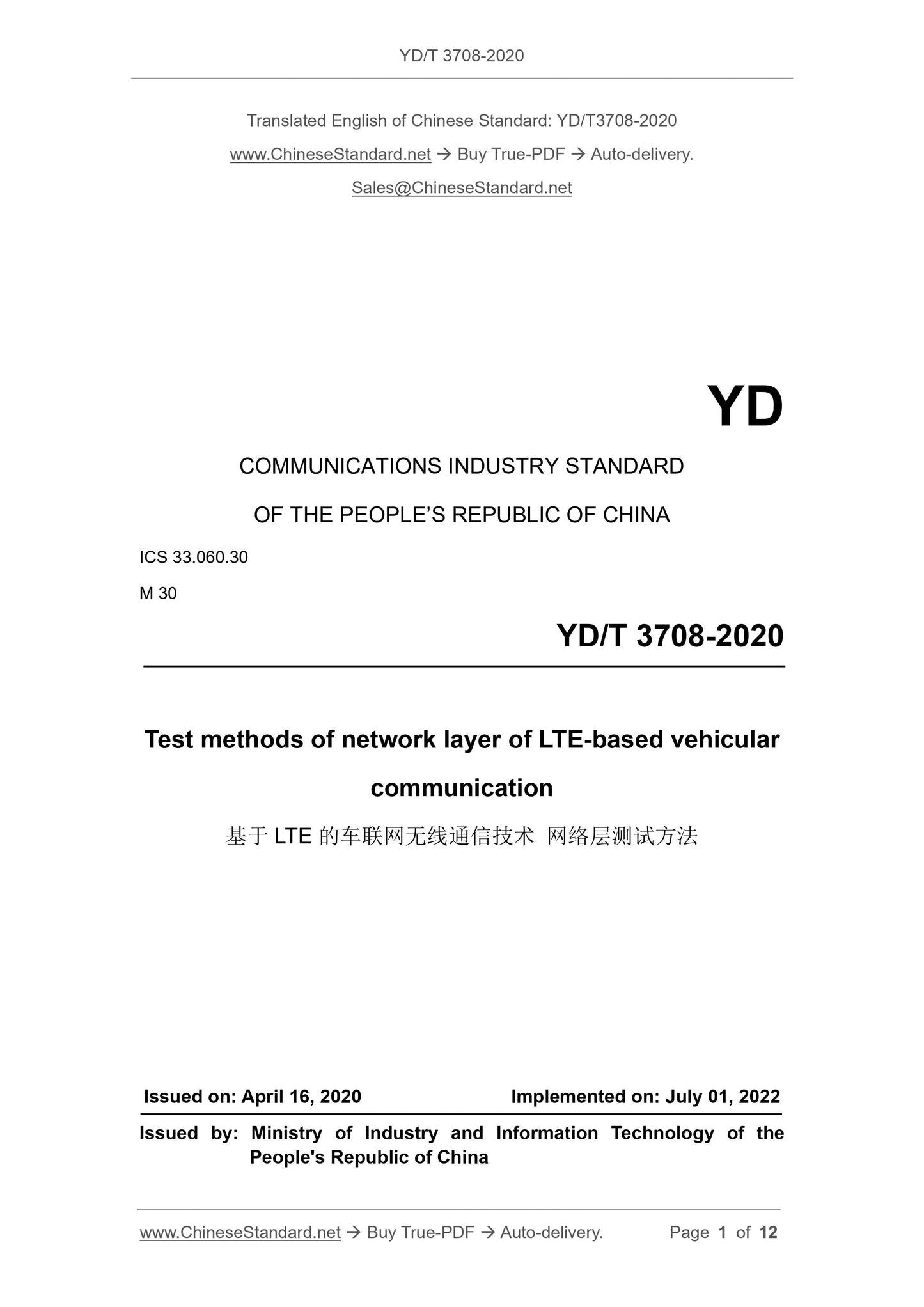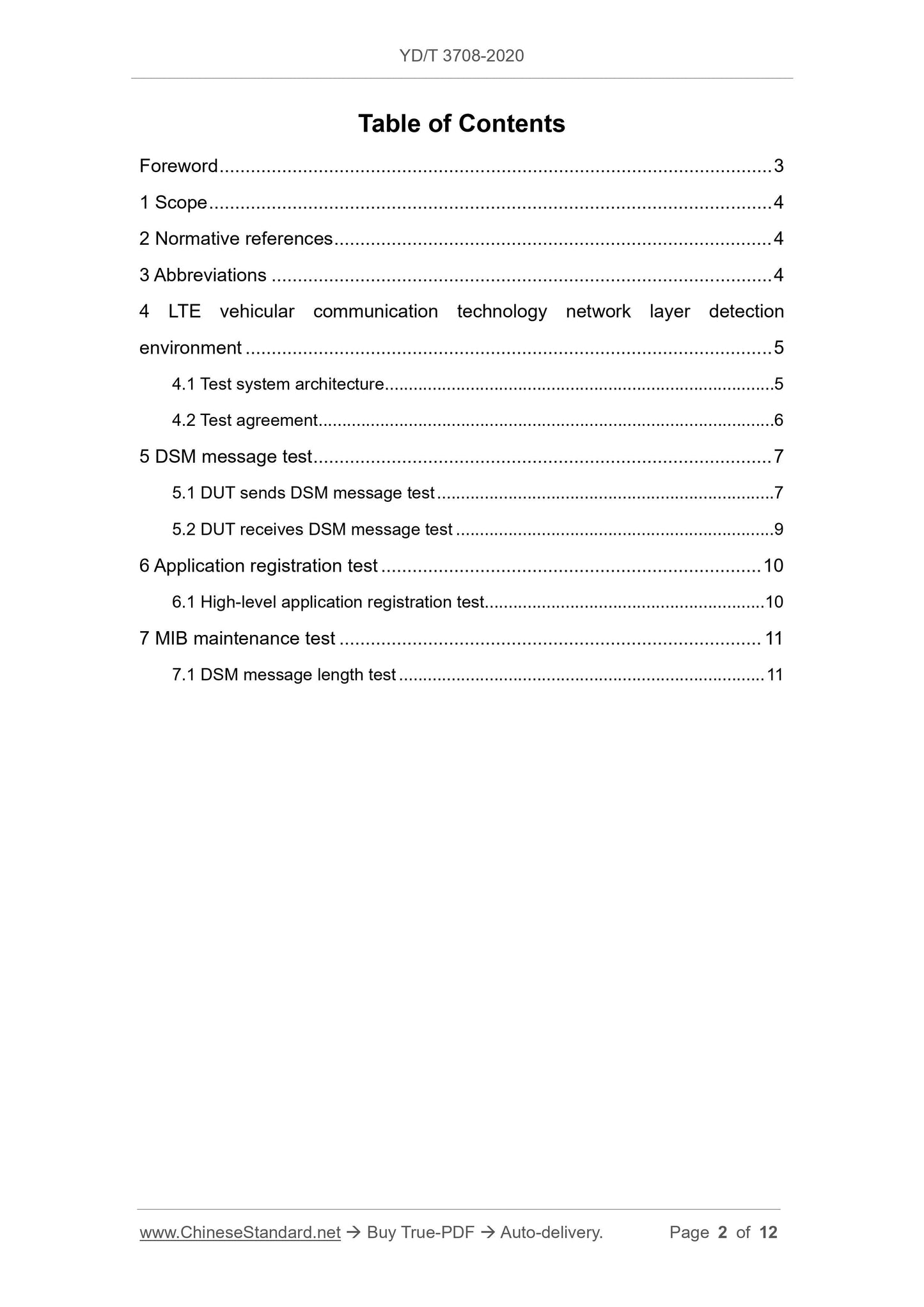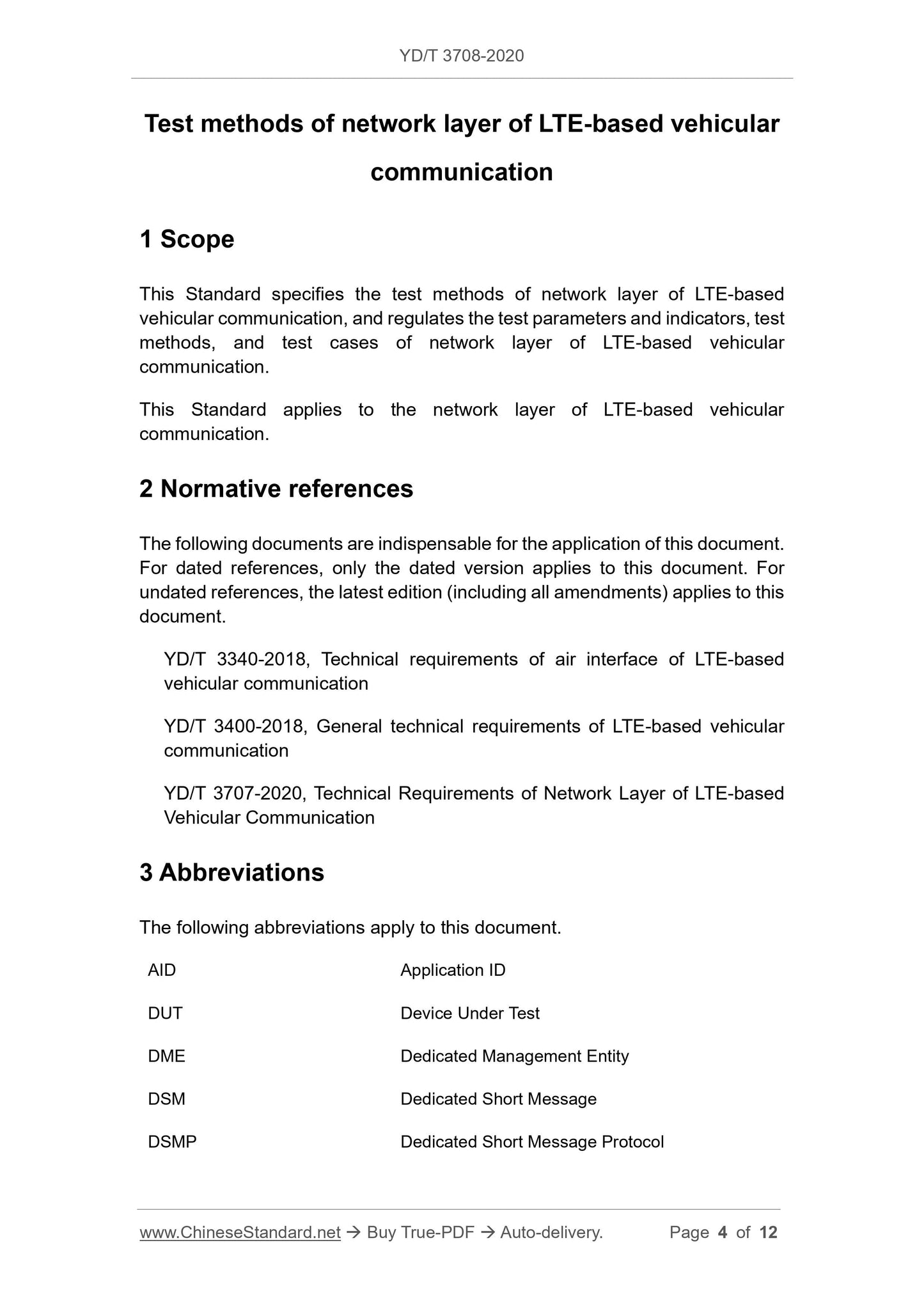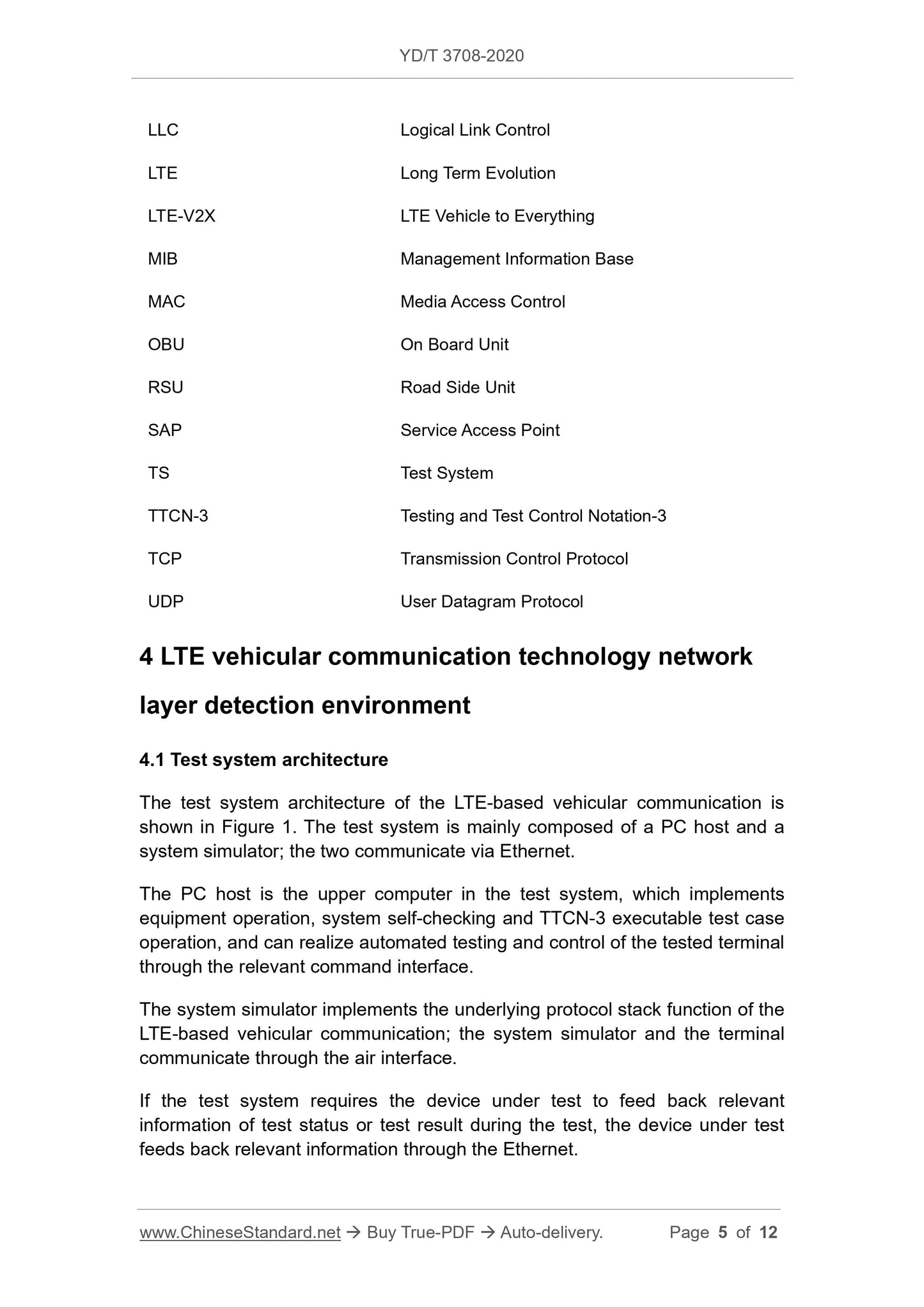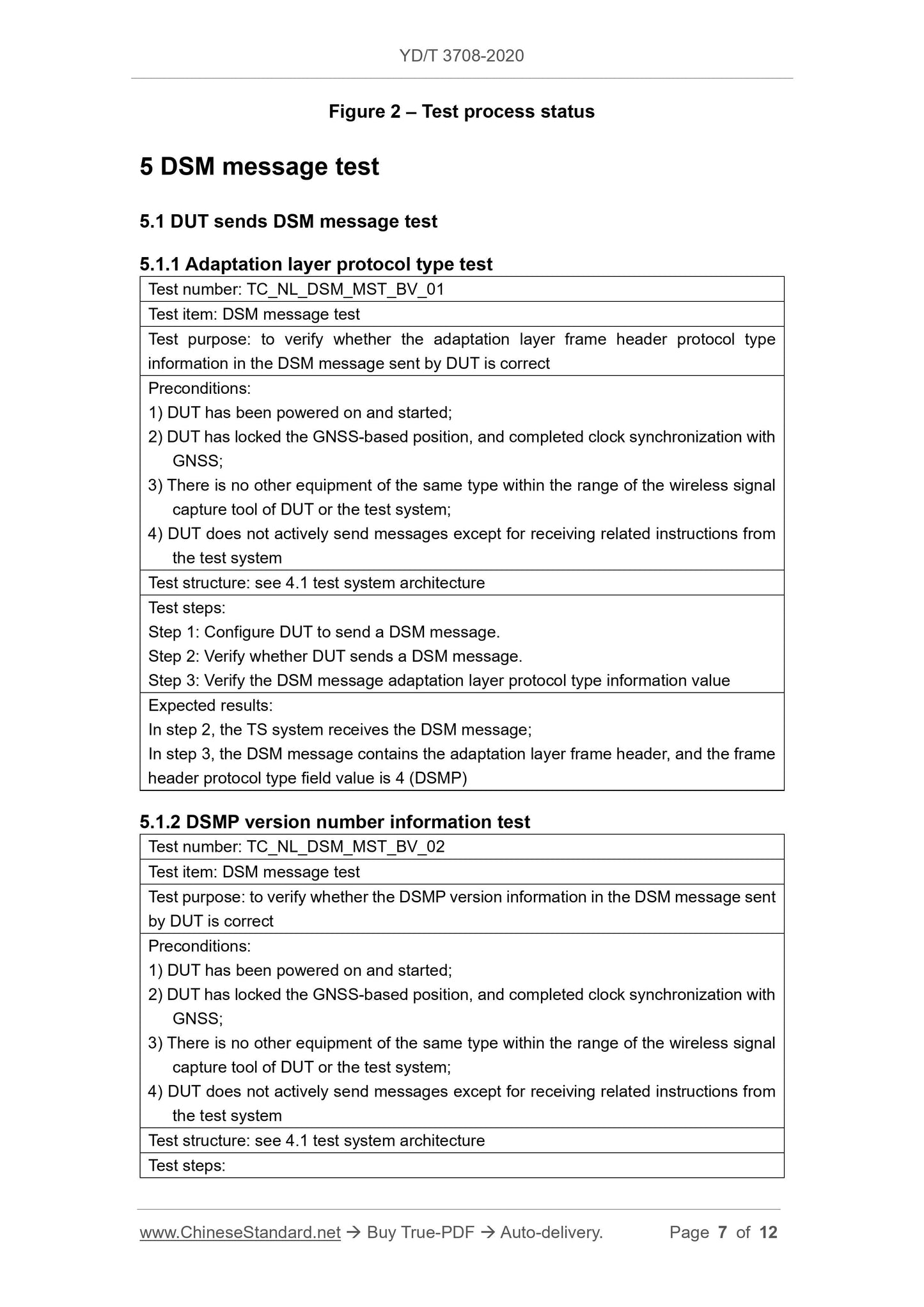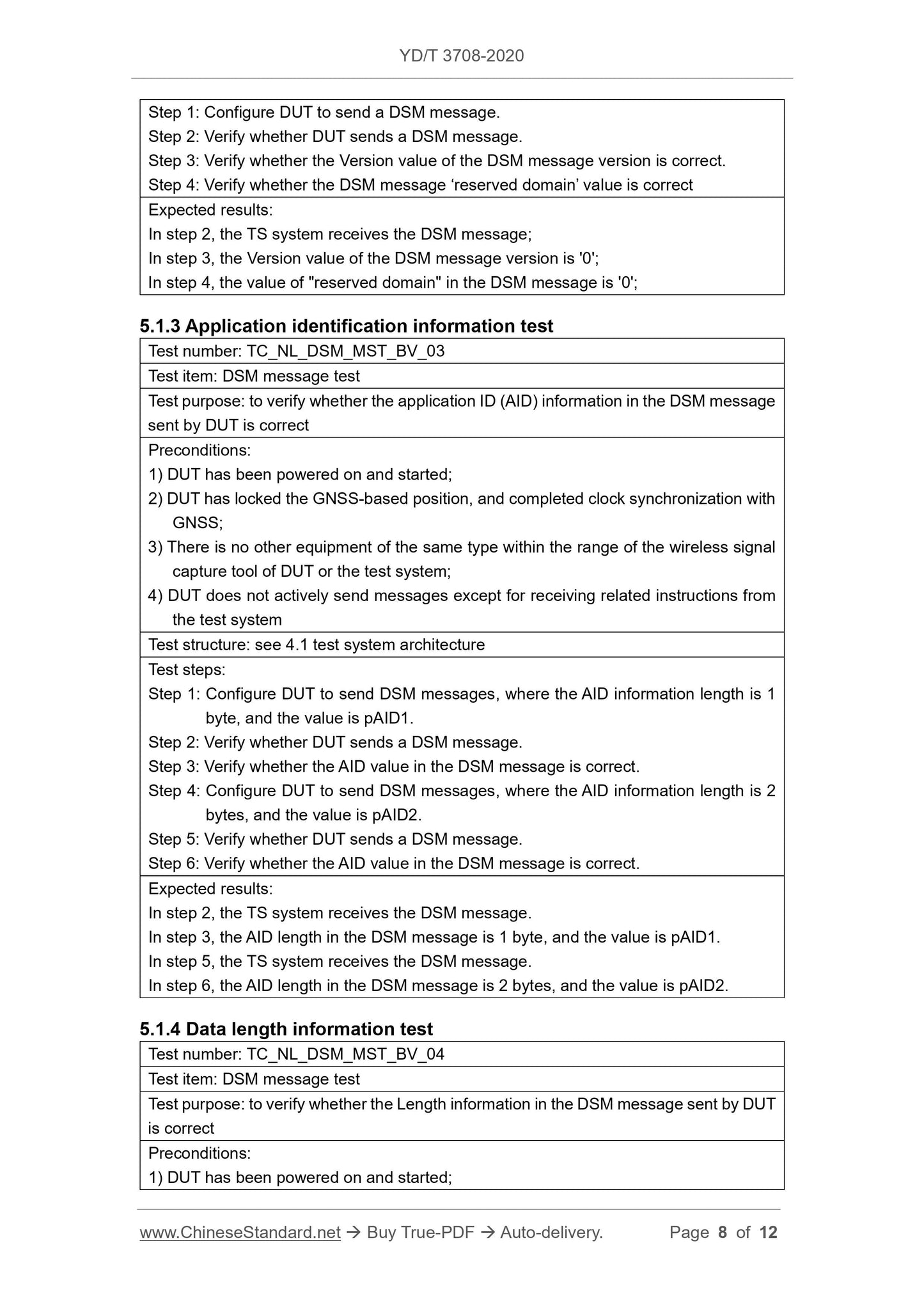1
/
of
6
PayPal, credit cards. Download editable-PDF and invoice in 1 second!
YD/T 3708-2020 English PDF (YD/T3708-2020)
YD/T 3708-2020 English PDF (YD/T3708-2020)
Regular price
$205.00 USD
Regular price
Sale price
$205.00 USD
Unit price
/
per
Shipping calculated at checkout.
Couldn't load pickup availability
Delivery: 3 seconds. Download true-PDF + Invoice.
Get QUOTATION in 1-minute: Click YD/T 3708-2020
Historical versions: YD/T 3708-2020
Preview True-PDF (Reload/Scroll if blank)
YD/T 3708-2020: Test methods of network layer of LTE-based vehicular communication
YD/T 3708-2020
YD
COMMUNICATIONS INDUSTRY STANDARD
OF THE PEOPLE’S REPUBLIC OF CHINA
ICS 33.060.30
M 30
Test methods of network layer of LTE-based vehicular
communication
ISSUED ON: APRIL 16, 2020
IMPLEMENTED ON: JULY 01, 2022
Issued by: Ministry of Industry and Information Technology of the
People's Republic of China
Table of Contents
Foreword ... 3
1 Scope ... 4
2 Normative references ... 4
3 Abbreviations ... 4
4 LTE vehicular communication technology network layer detection
environment ... 5
4.1 Test system architecture ... 5
4.2 Test agreement ... 6
5 DSM message test ... 7
5.1 DUT sends DSM message test ... 7
5.2 DUT receives DSM message test ... 9
6 Application registration test ... 10
6.1 High-level application registration test ... 10
7 MIB maintenance test ... 11
7.1 DSM message length test ... 11
Test methods of network layer of LTE-based vehicular
communication
1 Scope
This Standard specifies the test methods of network layer of LTE-based
vehicular communication, and regulates the test parameters and indicators, test
methods, and test cases of network layer of LTE-based vehicular
communication.
This Standard applies to the network layer of LTE-based vehicular
communication.
2 Normative references
The following documents are indispensable for the application of this document.
For dated references, only the dated version applies to this document. For
undated references, the latest edition (including all amendments) applies to this
document.
YD/T 3340-2018, Technical requirements of air interface of LTE-based
vehicular communication
YD/T 3400-2018, General technical requirements of LTE-based vehicular
communication
YD/T 3707-2020, Technical Requirements of Network Layer of LTE-based
Vehicular Communication
3 Abbreviations
The following abbreviations apply to this document.
AID Application ID
DUT Device Under Test
DME Dedicated Management Entity
DSM Dedicated Short Message
DSMP Dedicated Short Message Protocol
LLC Logical Link Control
LTE Long Term Evolution
LTE-V2X LTE Vehicle to Everything
MIB Management Information Base
MAC Media Access Control
OBU On Board Unit
RSU Road Side Unit
SAP Service Access Point
TS Test System
TTCN-3 Testing and Test Control Notation-3
TCP Transmission Control Protocol
UDP User Datagram Protocol
4 LTE vehicular communication technology network
layer detection environment
4.1 Test system architecture
The test system architecture of the LTE-based vehicular communication is
shown in Figure 1. The test system is mainly composed of a PC host and a
system simulator; the two communicate via Ethernet.
The PC host is the upper computer in the test system, which implements
equipment operation, system self-checking and TTCN-3 executable test case
operation, and can realize automated testing and control of the tested terminal
through the relevant command interface.
The system simulator implements the underlying protocol stack function of the
LTE-based vehicular communication; the system simulator and the terminal
communicate through the air interface.
If the test system requires the device under test to feed back relevant
information of test status or test result during the test, the device under test
feeds back relevant information through the Ethernet.
Figure 2 – Test process status
5 DSM message test
5.1 DUT sends DSM message test
5.1.1 Adaptation layer protocol type test
Test number: TC_NL_DSM_MST_BV_01
Test item: DSM message test
Test purpose: to verify whether the adaptation layer frame header protocol type
information in the DSM message sent by DUT is correct
Preconditions:
1) DUT has been powered on and started;
2) DUT has locked the GNSS-based position, and completed clock synchronization with
GNSS;
3) There is no other equipment of the same type within the range of the wireless signal
capture tool of DUT or the test system;
4) DUT does not actively send messages except for receiving related instructions from
the test system
Test structure: see 4.1 test system architecture
Test steps:
Step 1: Configure DUT to send a DSM message.
Step 2: Verify whether DUT sends a DSM message.
Step 3: Verify the DSM message adaptation layer protocol type information value
Expected results:
In step 2, the TS system receives the DSM message;
In step 3, the DSM message contains the adaptation layer frame header, and the frame
header protocol type field value is 4 (DSMP)
5.1.2 DSMP version number information test
Test number: TC_NL_DSM_MST_BV_02
Test item: DSM message test
Test purpose: to verify whether the DSMP version information in the DSM message sent
by DUT is correct
Preconditions:
1) DUT has been powered on and started;
2) DUT has locked the GNSS-based position, and completed clock synchronization with
GNSS;
3) There is no other equipment of the same type within the range of the wireless signal
capture tool of DUT or the test system;
4) DUT does not actively send messages except for receiving related instructions from
the test system
Test structure: see 4.1 test system architecture
Test steps:
Step 1: Configure DUT to send a DSM message.
Step 2: Verify whether DUT sends a DSM message.
Step 3: Verify whether the Version value of the DSM message version is correct.
Step 4: Verify whether the DSM message ‘reserved domain’ value is correct
Expected results:
In step 2, the TS system receives the DSM message;
In step 3, the Version value of the DSM message version is '0';
In step 4, the value of "reserved domain" in the DSM message is '0';
5.1.3 Application identification information test
Test number: TC_NL_DSM_MST_BV_03
Test item: DSM message test
Test purpose: to verify whether the application ID (AID) information in the DSM message
sent by DUT is correct
Preconditions:
1) DUT has been powered on and started;
2) DUT has locked the GNSS-based position, and completed clock synchronization with
GNSS;
3) There is no other equipment of the same type within the range of the wireless signal
capture tool of DUT or the test system;
4) DUT does not actively send messages except for receiving related instructions from
the test system
Test structure: see 4.1 test system architecture
Test steps:
Step 1: Configure DUT to send DSM messages, where the AID information length is 1
byte, and the value is pAID1.
Step 2: Verify whether DUT sends a DSM message.
Step 3: Verify whether the AID value in the DSM message is correct.
Step 4: Configure DUT to send DSM messages, where the AID information length is 2
bytes, and the value is pAID2.
Step 5: Verify whether DUT sends a DSM message.
Step 6: Verify whether the AID value in the DSM message is correct.
Expected results:
In step 2, the TS system receives the DSM message.
In step 3, the AID length in the DSM message is 1 byte, and the value is pAID1.
In step 5, the TS system receives the DSM message.
In step 6, the AID length in the DSM message is 2 bytes, and the value is pAID2.
5.1.4 Data length information test
Test number: TC_NL_DSM_MST_BV_04
Test item: DSM message test
Test purpose: to verify whether the Length information in the DSM message sent by DUT
is correct
Preconditions:
1) DUT has been powered on and started;
Get QUOTATION in 1-minute: Click YD/T 3708-2020
Historical versions: YD/T 3708-2020
Preview True-PDF (Reload/Scroll if blank)
YD/T 3708-2020: Test methods of network layer of LTE-based vehicular communication
YD/T 3708-2020
YD
COMMUNICATIONS INDUSTRY STANDARD
OF THE PEOPLE’S REPUBLIC OF CHINA
ICS 33.060.30
M 30
Test methods of network layer of LTE-based vehicular
communication
ISSUED ON: APRIL 16, 2020
IMPLEMENTED ON: JULY 01, 2022
Issued by: Ministry of Industry and Information Technology of the
People's Republic of China
Table of Contents
Foreword ... 3
1 Scope ... 4
2 Normative references ... 4
3 Abbreviations ... 4
4 LTE vehicular communication technology network layer detection
environment ... 5
4.1 Test system architecture ... 5
4.2 Test agreement ... 6
5 DSM message test ... 7
5.1 DUT sends DSM message test ... 7
5.2 DUT receives DSM message test ... 9
6 Application registration test ... 10
6.1 High-level application registration test ... 10
7 MIB maintenance test ... 11
7.1 DSM message length test ... 11
Test methods of network layer of LTE-based vehicular
communication
1 Scope
This Standard specifies the test methods of network layer of LTE-based
vehicular communication, and regulates the test parameters and indicators, test
methods, and test cases of network layer of LTE-based vehicular
communication.
This Standard applies to the network layer of LTE-based vehicular
communication.
2 Normative references
The following documents are indispensable for the application of this document.
For dated references, only the dated version applies to this document. For
undated references, the latest edition (including all amendments) applies to this
document.
YD/T 3340-2018, Technical requirements of air interface of LTE-based
vehicular communication
YD/T 3400-2018, General technical requirements of LTE-based vehicular
communication
YD/T 3707-2020, Technical Requirements of Network Layer of LTE-based
Vehicular Communication
3 Abbreviations
The following abbreviations apply to this document.
AID Application ID
DUT Device Under Test
DME Dedicated Management Entity
DSM Dedicated Short Message
DSMP Dedicated Short Message Protocol
LLC Logical Link Control
LTE Long Term Evolution
LTE-V2X LTE Vehicle to Everything
MIB Management Information Base
MAC Media Access Control
OBU On Board Unit
RSU Road Side Unit
SAP Service Access Point
TS Test System
TTCN-3 Testing and Test Control Notation-3
TCP Transmission Control Protocol
UDP User Datagram Protocol
4 LTE vehicular communication technology network
layer detection environment
4.1 Test system architecture
The test system architecture of the LTE-based vehicular communication is
shown in Figure 1. The test system is mainly composed of a PC host and a
system simulator; the two communicate via Ethernet.
The PC host is the upper computer in the test system, which implements
equipment operation, system self-checking and TTCN-3 executable test case
operation, and can realize automated testing and control of the tested terminal
through the relevant command interface.
The system simulator implements the underlying protocol stack function of the
LTE-based vehicular communication; the system simulator and the terminal
communicate through the air interface.
If the test system requires the device under test to feed back relevant
information of test status or test result during the test, the device under test
feeds back relevant information through the Ethernet.
Figure 2 – Test process status
5 DSM message test
5.1 DUT sends DSM message test
5.1.1 Adaptation layer protocol type test
Test number: TC_NL_DSM_MST_BV_01
Test item: DSM message test
Test purpose: to verify whether the adaptation layer frame header protocol type
information in the DSM message sent by DUT is correct
Preconditions:
1) DUT has been powered on and started;
2) DUT has locked the GNSS-based position, and completed clock synchronization with
GNSS;
3) There is no other equipment of the same type within the range of the wireless signal
capture tool of DUT or the test system;
4) DUT does not actively send messages except for receiving related instructions from
the test system
Test structure: see 4.1 test system architecture
Test steps:
Step 1: Configure DUT to send a DSM message.
Step 2: Verify whether DUT sends a DSM message.
Step 3: Verify the DSM message adaptation layer protocol type information value
Expected results:
In step 2, the TS system receives the DSM message;
In step 3, the DSM message contains the adaptation layer frame header, and the frame
header protocol type field value is 4 (DSMP)
5.1.2 DSMP version number information test
Test number: TC_NL_DSM_MST_BV_02
Test item: DSM message test
Test purpose: to verify whether the DSMP version information in the DSM message sent
by DUT is correct
Preconditions:
1) DUT has been powered on and started;
2) DUT has locked the GNSS-based position, and completed clock synchronization with
GNSS;
3) There is no other equipment of the same type within the range of the wireless signal
capture tool of DUT or the test system;
4) DUT does not actively send messages except for receiving related instructions from
the test system
Test structure: see 4.1 test system architecture
Test steps:
Step 1: Configure DUT to send a DSM message.
Step 2: Verify whether DUT sends a DSM message.
Step 3: Verify whether the Version value of the DSM message version is correct.
Step 4: Verify whether the DSM message ‘reserved domain’ value is correct
Expected results:
In step 2, the TS system receives the DSM message;
In step 3, the Version value of the DSM message version is '0';
In step 4, the value of "reserved domain" in the DSM message is '0';
5.1.3 Application identification information test
Test number: TC_NL_DSM_MST_BV_03
Test item: DSM message test
Test purpose: to verify whether the application ID (AID) information in the DSM message
sent by DUT is correct
Preconditions:
1) DUT has been powered on and started;
2) DUT has locked the GNSS-based position, and completed clock synchronization with
GNSS;
3) There is no other equipment of the same type within the range of the wireless signal
capture tool of DUT or the test system;
4) DUT does not actively send messages except for receiving related instructions from
the test system
Test structure: see 4.1 test system architecture
Test steps:
Step 1: Configure DUT to send DSM messages, where the AID information length is 1
byte, and the value is pAID1.
Step 2: Verify whether DUT sends a DSM message.
Step 3: Verify whether the AID value in the DSM message is correct.
Step 4: Configure DUT to send DSM messages, where the AID information length is 2
bytes, and the value is pAID2.
Step 5: Verify whether DUT sends a DSM message.
Step 6: Verify whether the AID value in the DSM message is correct.
Expected results:
In step 2, the TS system receives the DSM message.
In step 3, the AID length in the DSM message is 1 byte, and the value is pAID1.
In step 5, the TS system receives the DSM message.
In step 6, the AID length in the DSM message is 2 bytes, and the value is pAID2.
5.1.4 Data length information test
Test number: TC_NL_DSM_MST_BV_04
Test item: DSM message test
Test purpose: to verify whether the Length information in the DSM message sent by DUT
is correct
Preconditions:
1) DUT has been powered on and started;
Share
